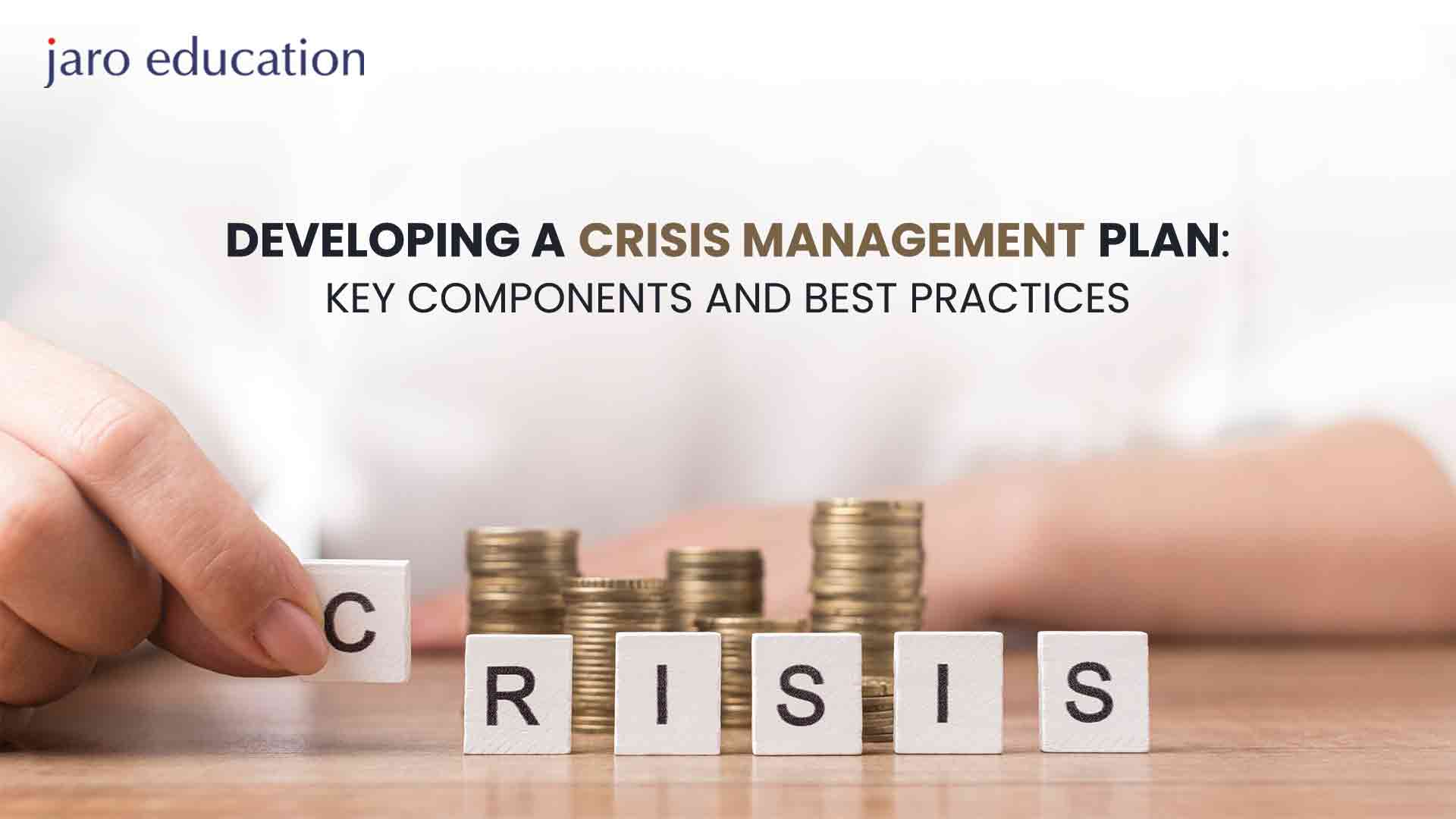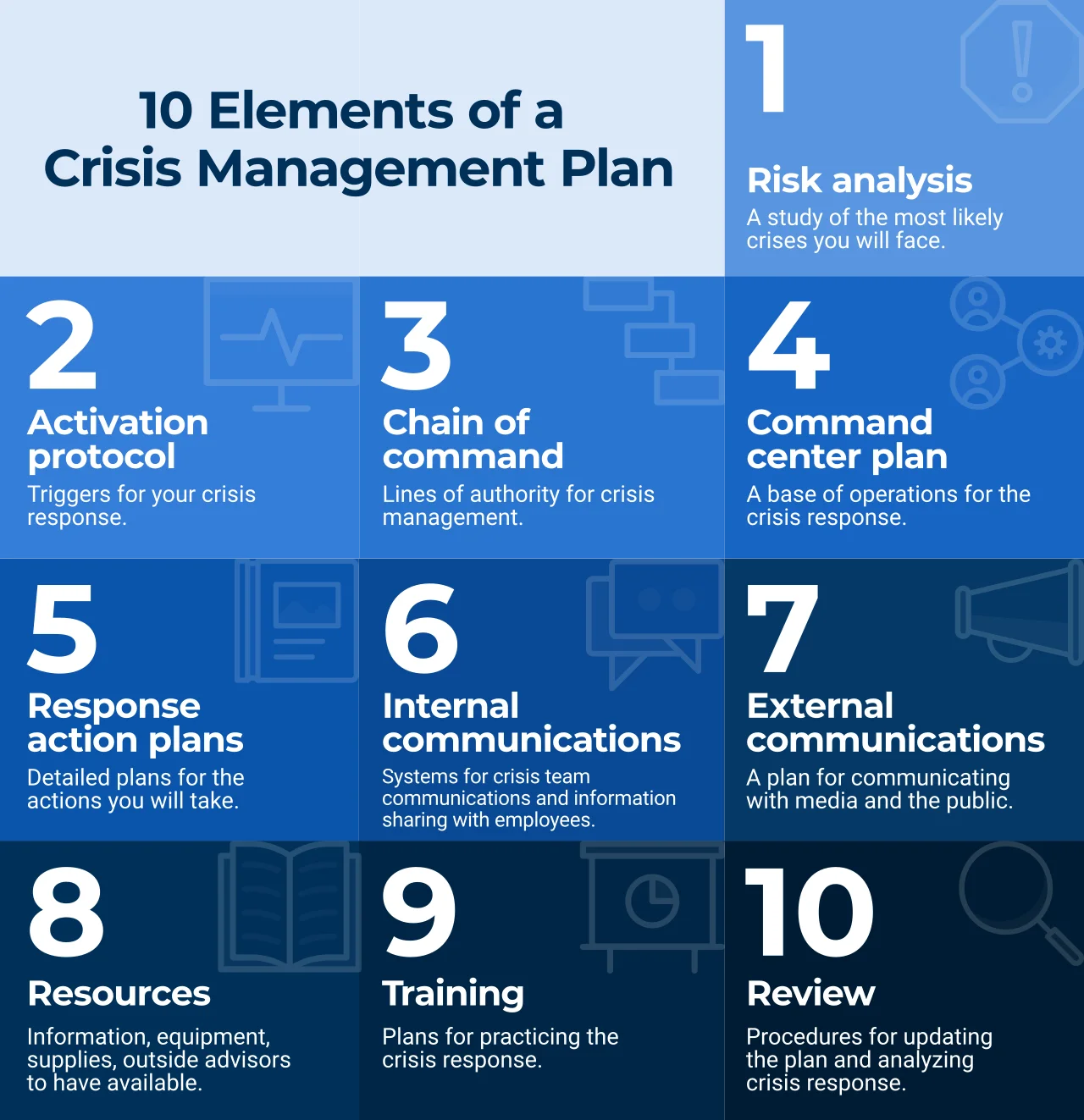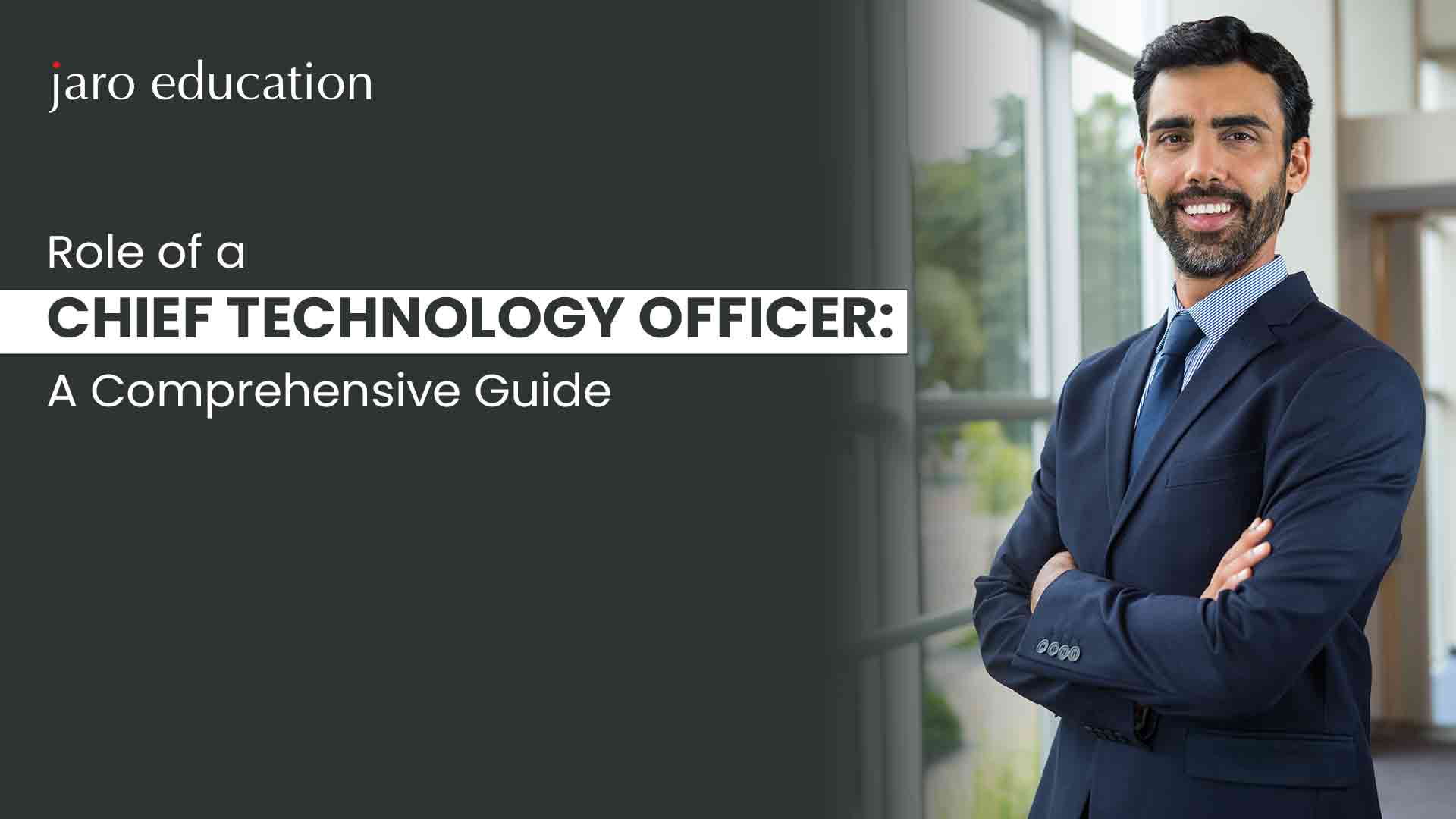Developing a Crisis Management Plan: Key Components and Best Practices
Table of Contents

- jaro education
- 1, May 2024
- 10:46 am
In the present unpredictable and unforeseeable business environment, organisations must be prepared to respond effectively to potential crises. Thus, creating a complete strategy for handling crises is critical for mitigating risks, minimising disruptions, and protecting the organisation’s reputation and interests. This blog will look at the key components and best practices involved in developing a strong crisis management plan that provides businesses with the tools and strategies they need to navigate challenges with resilience and agility.
Types of Crisis Requiring Critical Management
The types of crisis are as follows:
- Accidental Disasters: Accidental disasters, often caused by human error, pose significant threats to organisations. Examples include fires in industries like mining and construction, leading to workforce casualties and extensive damage.
- Natural Disasters: Environmental crises such as earthquakes, tornadoes, and floods are beyond human control and can severely impact organisational operations.
- Technology Disasters: Technology plays a crucial role in modern organisations, making them vulnerable to disruptions. These can range from accidental system failures to malicious cybercrime activities like theft and virus attacks.
- Conflict of Interest Crisis: These crises involve political complexities and can be challenging to navigate. Examples include rumours spreading false information about products, product tampering by rivals, and headhunting of top executives by competitors. Effective crisis management strategies and proactive public relations efforts are essential to mitigate the damage caused by these crises.
Understanding Crisis Management Plans
A crisis management plan is a crucial document that outlines how your business will respond in the event of a crisis. It delineates the individuals responsible for taking action and specifies their roles. The primary objective of such a plan is to mitigate damage and swiftly restore normal business operations. This plan serves as a dynamic guide that your team can refer to and update regularly. While there’s no predicting the exact nature or timing of a crisis, conducting a risk analysis can provide insight into potential threats your company may encounter. For instance, a social media marketing firm may anticipate organisational mishaps requiring public apologies, while a tech company might brace for cyberattacks. Understanding your industry can help identify potential crises and devise effective strategies to address them.
Essential Elements of a Complete Crisis Management Plan
Any organisation must have a well-structured crisis management plan when faced with unexpected challenges. This plan includes essential components designed for risk prevention, effective communication, emergency plans, and continuous improvement. Here’s an elaboration on the main components:

*smartsheet.com
Risk Assessment
A thorough risk assessment serves as the foundation of a crisis management plan. It involves identifying stakeholders, evaluating potential threats and vulnerabilities, and devising strategies for risk mitigation. Organisations can proactively address potential crises by understanding the risks associated with various incidents.
Communication Plan
Effective communication is paramount during a crisis. A robust communication plan outlines strategies for engaging employees, customers, partners, and other stakeholders. This includes developing clear messaging to address public fallout and mitigate internal communication challenges. Establishing communication channels and protocols ensures timely and transparent dissemination of information.
Contingency Plan
A contingency plan delineates specific steps for recovering from a crisis swiftly and efficiently. This may involve developing backup plans for critical systems, identifying alternative suppliers to address supply chain disruptions, and implementing measures to restore operations as quickly as possible. Thus, having a well-defined contingency plan minimises downtime and mitigates the impact of the crisis on business operations.
Audit and Training
Regular audits and training sessions are essential for maintaining the effectiveness of the crisis management plan. This involves reviewing and updating the plan to address evolving threats and vulnerabilities. Conducting incident response drills and training sessions ensures that employees are well-prepared to respond to crisis effectively. By knowing the latest best practices, organisations can enhance their crisis response capabilities and minimise potential risks.
Consistent Communication Strategy
In addition to the elements outlined in the plan, it’s crucial to establish a consistent communication strategy for disseminating information about the crisis management plan. This may involve utilising internal newsletters, mass text messaging, or other communication channels that best suit the organisation’s needs. Consistency in communication ensures that stakeholders are well-informed and prepared to respond to crisis effectively.
Crisis Management Best Practices: 7 Vital Steps
Here are seven essential steps to guide you in creating crisis management best practices:
1. Formulate a Dedicated Crisis Management Team
Initiate by assembling a proficient crisis management team, comprising individuals from diverse departments with relevant expertise and decision-making authority. This team will spearhead crisis response efforts, ensuring a coordinated and efficient approach.
2. Conduct a Thorough Risk Assessment
Undertake a comprehensive evaluation of potential risks and vulnerabilities facing your organisation. Assess the likelihood and potential impact of each risk to prioritise focus areas and allocate resources effectively.
3. Develop a Detailed Crisis Response Plan
Craft a comprehensive crisis response plan delineating step-by-step procedures to be followed during a crisis. Clearly define roles, responsibilities, communication protocols, and escalation procedures. Tailor the plan to address various crisis scenarios your organisation may encounter.
4. Establish Effective Communication Channels
Establish robust communication channels to facilitate smooth information flow internally and externally. Set up dedicated crisis hotlines, create internal communication networks, and engage with media outlets to disseminate accurate and timely information during a crisis.
5. Conduct Regular Training and Drills
Regularly train your crisis management team and employees on crisis response procedures. Conduct mock drills and simulations to test the effectiveness of your crisis management plan, identifying areas for improvement and enhancing preparedness.
6. Implement Ongoing Monitoring and Evaluation
Adopt a systematic approach to monitor and evaluate potential crisis triggers. Stay vigilant about emerging risks, continuously assess their relevance, and update your crisis response plan accordingly. Regularly review response effectiveness and make necessary adjustments.
7. Incorporate Workflow Management Systems
Integrate workflow management systems or software to streamline the crisis management process. These tools enable the creation of standardised workflows, task assignments, and tracking, ensuring efficient execution of the crisis response plan.
By implementing a well-defined crisis management plan, organisations can anticipate and respond to phases of crisis management effectively, minimise disruptions, safeguard reputation, and demonstrate commitment to responsible and effective crisis management.
Role of a Crisis Management Team
A Crisis Management Team, also referred to as a CMT, incident management team, or corporate incident response team, plays a pivotal role in preparing and responding to potential emergencies within an organisation. Comprising designated leaders and team members with specific responsibilities, the CMT ensures effective coordination and execution of response efforts during actual disasters.
Structure and Responsibilities
A leader heads the crisis management team, with team members assigned roles like planning or logistics. Together, they possess the authority to make critical decisions under dire circumstances, guiding the organisation through crisis.
Adaptability and Specialisation
In larger organisations, the CMT may include subteams led by their respective leaders, focusing on specific work streams or geographic areas. Depending on the severity and nature of the crisis, activation of all roles may not be necessary for every scenario.
Composition of the Team
Members of the crisis management team are typically employees holding other positions within the organisation. This diverse composition may include human resources managers, department heads, senior managers, public relations representatives, communications and marketing executives, key operational staff, and site managers.
Collaborative Response
During a crisis, the CRM collaborates closely to assess the situation, develop response strategies, and communicate effectively with internal and external stakeholders. Their collective expertise and swift decision-making are instrumental in navigating the organisation through challenging circumstances.
Executing the Crisis Management Plan
Following the development of a comprehensive crisis management plan, the crucial step is its implementation. This phase tests the plan’s responsiveness and efficacy in real-world scenarios, shedding light on its strengths and areas for enhancement.
Real-World Scenario: Crisis Response in Motion
In the event of a crisis, swift and effective action is important. Here’s an outline of how the plan is activated and the crisis team is coordinated:
- Activation of the Plan: Upon detecting a potential crisis, the incident response team reports to the crisis manager, who promptly evaluates the severity of the situation. If confirmed, the crisis management plan (CMP) is activated, mobilising the crisis team to initiate the pre-established action plan.
- Decision-Making Amid Crisis: The crisis manager, in collaboration with the crisis team, assumes responsibility for critical decisions. These may involve declaring an emergency, allocating resources, or engaging stakeholders. Decisions are anchored in the guiding principles outlined in the CMP.
- Coordinated Crisis Response: The crisis manager orchestrates the crisis team’s efforts, assigning tasks, mobilising resources, and facilitating communication among team members. Effective coordination ensures a cohesive and efficient response to the crisis.
Key Challenges in Crisis Response
Despite meticulous planning, responding to a crisis presents challenges:
- Communication Hurdles: A crisis can fuel miscommunication, leading to confusion and unrest. Clear, consistent, and frequent communication is vital to ensure all stakeholders remain informed and aligned.
- Leadership Amidst Pressure: Crisis test leadership capabilities, demanding decisive action under intense scrutiny and time constraints. Leaders must exhibit composure, courage, and clarity in their decision-making.
- Adaptation to Dynamic Conditions: Crises are fluid situations that evolve rapidly. The crisis team must adeptly adjust their response as circumstances change, necessitating agility, rapid thinking, and sound judgment under pressure.
Conclusion
Organisations must develop effective crisis management plans that include types of crisis management, risk assessments, communication protocols, contingency plans, and continuous improvement measures. Putting these plans into action requires dedicated teams, effective communication channels, workflow management systems, adaptability, collaboration, and decisive leadership. Prioritising crisis preparedness offers a competitive advantage and resilience. Chief Technology Officer Programme – CEP, IIT Delhi prepares professionals to lead technology-driven organisations through strategic management, innovation, and digital transformation. This 10-month-long course offers live interactive sessions with IIT Delhi faculty. You also get to be part of case study drive learning, which enhances your experience and helps navigate your professional endeavours. From networking opportunities to exposure to global best practices, this course is an all-in-all platform for career development.









